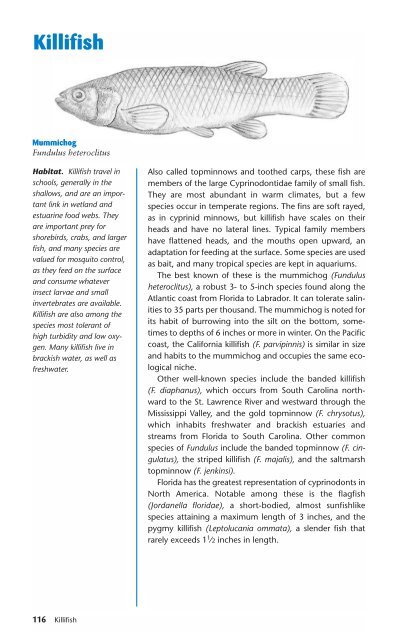Ken Schultz's Field Guide to Saltwater Fish - Macaw Pets store
Ken Schultz's Field Guide to Saltwater Fish - Macaw Pets store
Ken Schultz's Field Guide to Saltwater Fish - Macaw Pets store
You also want an ePaper? Increase the reach of your titles
YUMPU automatically turns print PDFs into web optimized ePapers that Google loves.
Killifish<br />
Mummichog<br />
Fundulus heteroclitus<br />
Habitat. Killifish travel in<br />
schools, generally in the<br />
shallows, and are an important<br />
link in wetland and<br />
estuarine food webs. They<br />
are important prey for<br />
shorebirds, crabs, and larger<br />
fish, and many species are<br />
valued for mosqui<strong>to</strong> control,<br />
as they feed on the surface<br />
and consume whatever<br />
insect larvae and small<br />
invertebrates are available.<br />
Killifish are also among the<br />
species most <strong>to</strong>lerant of<br />
high turbidity and low oxygen.<br />
Many killifish live in<br />
brackish water, as well as<br />
freshwater.<br />
116 Killifish<br />
Also called <strong>to</strong>pminnows and <strong>to</strong>othed carps, these fish are<br />
members of the large Cyprinodontidae family of small fish.<br />
They are most abundant in warm climates, but a few<br />
species occur in temperate regions. The fins are soft rayed,<br />
as in cyprinid minnows, but killifish have scales on their<br />
heads and have no lateral lines. Typical family members<br />
have flattened heads, and the mouths open upward, an<br />
adaptation for feeding at the surface. Some species are used<br />
as bait, and many tropical species are kept in aquariums.<br />
The best known of these is the mummichog (Fundulus<br />
heteroclitus), a robust 3- <strong>to</strong> 5-inch species found along the<br />
Atlantic coast from Florida <strong>to</strong> Labrador. It can <strong>to</strong>lerate salinities<br />
<strong>to</strong> 35 parts per thousand. The mummichog is noted for<br />
its habit of burrowing in<strong>to</strong> the silt on the bot<strong>to</strong>m, sometimes<br />
<strong>to</strong> depths of 6 inches or more in winter. On the Pacific<br />
coast, the California killifish (F. parvipinnis) is similar in size<br />
and habits <strong>to</strong> the mummichog and occupies the same ecological<br />
niche.<br />
Other well-known species include the banded killifish<br />
(F. diaphanus), which occurs from South Carolina northward<br />
<strong>to</strong> the St. Lawrence River and westward through the<br />
Mississippi Valley, and the gold <strong>to</strong>pminnow (F. chrysotus),<br />
which inhabits freshwater and brackish estuaries and<br />
streams from Florida <strong>to</strong> South Carolina. Other common<br />
species of Fundulus include the banded <strong>to</strong>pminnow (F. cingulatus),<br />
the striped killifish (F. majalis), and the saltmarsh<br />
<strong>to</strong>pminnow (F. jenkinsi).<br />
Florida has the greatest representation of cyprinodonts in<br />
North America. Notable among these is the flagfish<br />
(Jordanella floridae), a short-bodied, almost sunfishlike<br />
species attaining a maximum length of 3 inches, and the<br />
pygmy killifish (Lep<strong>to</strong>lucania ommata), a slender fish that<br />
rarely exceeds 1 1 ⁄2 inches in length.


